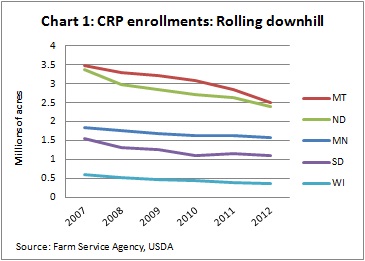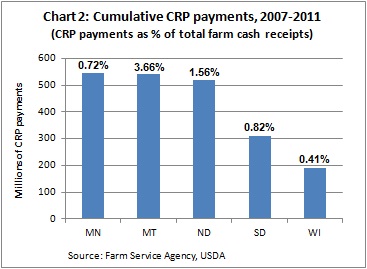Critics of farm subsidies often say the programs “pay farmers not to farm.” While that isn’t a fair characterization of most ag policy, it is literally true of the Conservation Reserve Program, where farmers can collect rental payments from the federal government for voluntarily pulling certain acres from production and returning them to a more natural state.
While that might sound like a can’t-lose business model, farmers across the country and Ninth District have been pulling acreage out of CRP at a fast pace since the recession. From 2000 to 2006, the program saw little fluctuation in enrolled acres. But starting in 2007, district states saw a steady outflow of enrolled acres (see Chart 1). Montana and North Dakota each lost almost 1 million CRP acres over this period (about 29 percent of enrollment), while Wisconsin saw the biggest percentage drop (39 percent), but has easily the smallest enrollment among district states.

The decline in district states reflects—and is a big contributor toward—a broader decline in acreage nationally because the district has nearly 30 percent of all CRP acres. So what’s behind the decline? Simple cost-benefit analysis. Over the past few years, prices for corn, wheat and soybeans have been at sustained highs.
CRP rental rates are determined through a bidding process, whereby interested farmers submit a price at which they will remove acreage from production for 10 years, and the USDA picks which contracts it will purchase. Contract prices have been rising, but they haven’t kept up with crop prices—which, not coincidentally, started rising in 2007. So the fall in CRP acreage simply means farmers believe these acres will be more profitable in production than conservation.
In aggregate, CRP payments might seem big; farmers in each district state have received hundreds of millions of CRP dollars since 2007. But as Chart 2 shows, these payments are tiny relative to overall farm income, and they are likely to decline further if more land exits the program, as many expect. The fact that acres are enrolled under 10-year contracts has probably prevented a faster decline. Those contracts can provide some idea of where the program is heading, which will be the subject of a future Roundup post.

Joe Mahon is a Minneapolis Fed regional outreach director. Joe’s primary responsibilities involve tracking several sectors of the Ninth District economy, including agriculture, manufacturing, energy, and mining.





